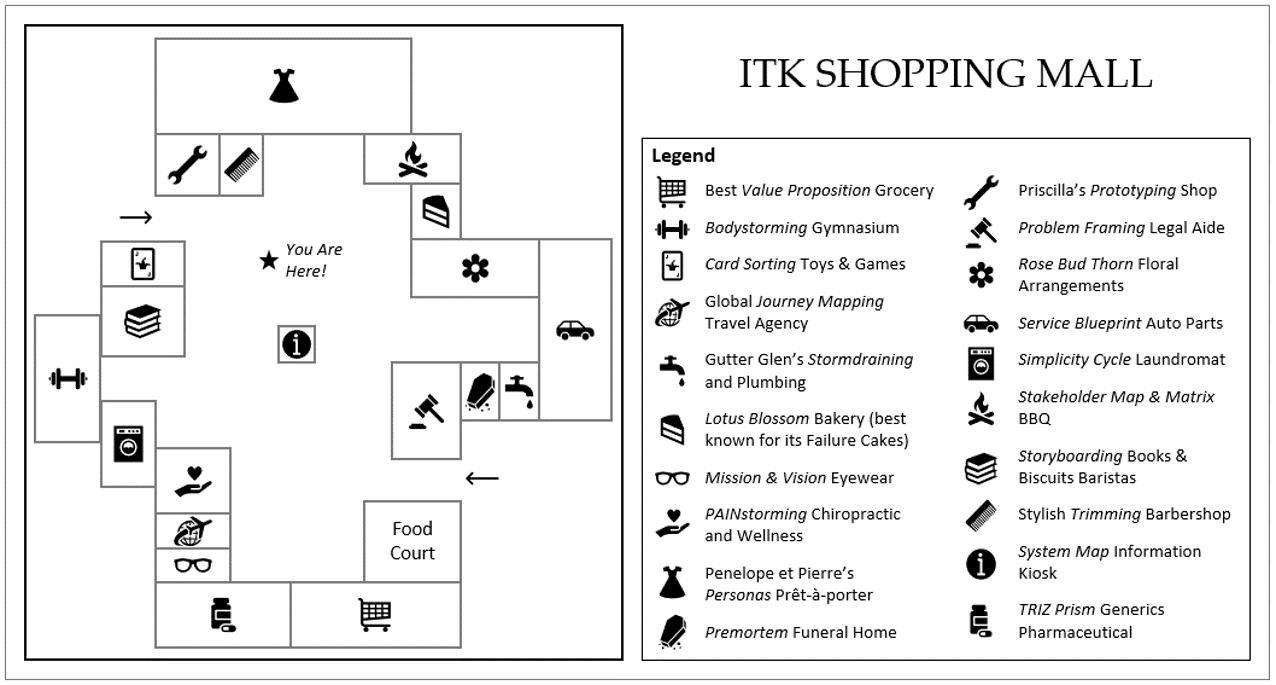
by dbward | Mar 28, 2022 | Misc Awesomeness, Success Stories |
This week’s post is by guest blogger Allison Khaw!
A few weeks ago, on my own time, I dove into a short-term creative project.
I was inspired by Karim Thompson on the Innovation Toolkit team: he invented a list of fictional strip mall business names based on some of the ITK tools. Functionally, the list helped you remember the tool names, but its intangible benefits went well beyond that. I remember how so many of us on the team were not only entertained but also energized by what he created. At some point, I concluded—this can’t be forgotten in the annals of team history!
Adapting Karim’s list into a more visual format seemed like a natural next step. I expanded the original list by adding a few business names of my own, and then I formed a map legend and designed a map layout. Several versions later, the final “ITK Shopping Mall Map” was born! It was quite an iterative process, and looking back, I asked myself:
What takeaways do I want to share as a result of this experience?
- Don’t limit yourself to a certain approach just because that’s how it’s been done before.
From the start, I planned to include this shopping mall map in our ITK Handbook, which is an ITK how-to guide and an informal sequel to our choose-your-own-adventure-style book The Toolbox of Innovation. Since I made line drawings by hand for our first book to resemble the CYOA books of the 80’s and 90’s, I originally planned to draw the map by hand as well. However, I realized that the non-CYOA style of the ITK Handbook opened up other possibilities. In fact, only after letting go of the “It’s always been done this way before!” argument did it become clear to me that electronically creating the map was the better option to begin with.
- Set yourself up for exploring new ideas by periodically saving backup versions.
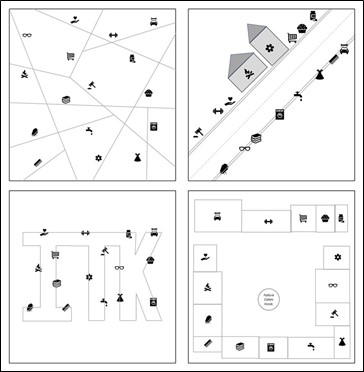
I decided to keep it simple by using PowerPoint as my creation software. As I developed the map, I got into the habit of duplicating my in-progress version and then working off of the newer copy, which resulted in dozens of sequential PowerPoint slides. Although this was a basic technique (thank you, copy and paste!), it made all the difference. It allowed me to incrementally move forward with new ideas in the design process—and if I liked an old idea better, I could always find my way back. To illustrate this, see the provided figure with four map versions at different points in the brainstorming process. Some versions were considerably better than others!
- To leave yourself room for inspiration, set minimal expectations and build flexibility around deadlines.
Given the nature of this side project, no one would have been upset if I didn’t finish it. In many ways, this was incredibly freeing. I was self-motivated to see my vision come to fruition, but I took my time looking into common shopping mall layouts and actually discovered one of my best design ideas after a leisurely session of experimentation. Even for projects with fixed deadlines, starting early to give yourself flexibility can be invaluable. Yes, sometimes constraints are useful, but other times the feeling of not being rushed can be exactly what you need to achieve results.
- The end result may seem obvious in hindsight, but the path it takes to get there is often quite the opposite.
A final product that looks simple and effortless usually belies the very effort that you put into it. What’s more, this is a good thing—it means that your hard work has paid off! I have experienced this before when using the Premortem and Mission & Vision Tool, and I found this to be true here too after following a winding path to reach the final design of the map. Blaise Pascal summarized it nicely back in the seventeenth century, when he is said to have penned, “I would have written a shorter letter, but I didn’t have the time.” We need to more consistently give ourselves the opportunity to go that extra mile—and write that shorter letter.
This side project was fulfilling in that it allowed me to breathe new life into the fictional ITK business names that Karim created. Not only did I learn valuable lessons from the iterative nature of the map design process, but each time I look back at the completed ITK Shopping Mall Map, I can’t help but grin at everything it represents.
More than anything, I consider that a measure of success if ever there was one. Best of luck on your own creative pursuits!
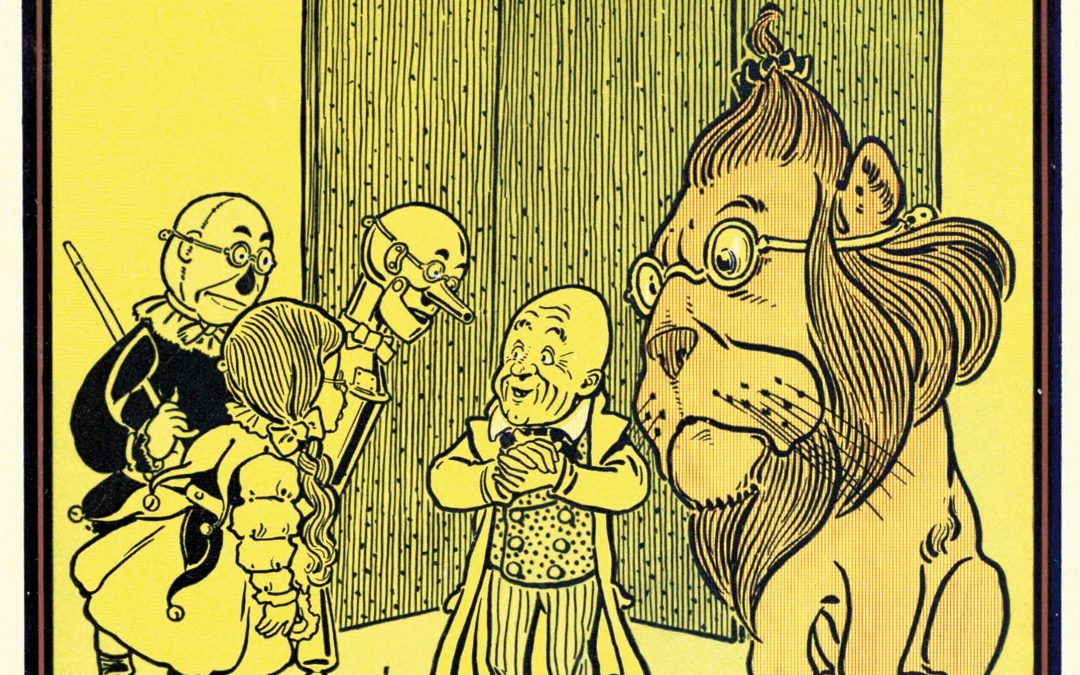
by dbward | Oct 25, 2021 | Facilitation Tips, Success Stories
This week’s guest blogger is Kerrianne Marino.
This summer, I facilitated a half-day workshop that focused on coming up with areas of exploration for Nuclear Command, Control, and Communications (NC3) systems. I agreed to facilitate the session because I saw it as an exciting challenge. Admittedly, I was naively excited to do an in-person event and talk to people face to face again after Covid yanked that benefit for over a year.
After I sent the ‘yes’ confirming I would facilitate, I felt the ‘oh no’ directly after and convinced myself I had no business leading an exercise on a topic I knew nothing about. When I came onto the effort, someone had already proposed a schedule of events, so I scheduled my initial conversation with those who submitted the ITK request to go over goals and expectations. They wanted to get a group of a dozen or so experts in a room to brainstorm and prioritize different ideas for a FY22 plan. This conversation made me feel slightly better, but only enough to know what I didn’t know.
A list of worries started running through my head…
- What if no one has ideas and we’re sitting in silence until I come up with an idea to write down and break the silence?
- What if that idea I present is STUPID and they all find out I know nothing about this space?
- What if I don’t know how to summarize someone’s idea onto a notecard?
- What if we miss documenting a bright idea?
- What if we run out of time?
- What if no one shows up?
- What if…
I asked the ITK group of trainees if anyone could help support and was able to bring someone onboard and brought them up to speed. I frantically asked one of the ITK veterans to hop on a call to walk us through best practices on the Card Sorting tool we were planning to use.
As we discussed best practices, I went on to admit I was nervous for the workshop, having had no experience in this domain. She looked at me with convincing eyes (yay for video cameras!) and replied, ‘But you do!’ And listed the ways in which I did have tangential knowledge related to workshop mission. I straightened up, and with her encouragement, snapped into the realization that my experience with Department of Justice, Department of Defense, and human-machine teaming projects would give me all I needed and more to push this group forward.
Jumping to facilitation day – the workshop went great! We started with defining the problem statement in the form of a ‘How might we?’ question, and I even helped by throwing ideas on the board, which led to productive discussion. The card sorting activity unlocked so many insightful discussions.
I was surprised to notice that for a good chunk of time, the leads came short of introducing ideas. This made me realize- that’s why I am here. To shepherd this group into a think-tank and feed them the materials they need to set their ideas in motion.
We documented the topics and ideas people came up with, as well as some themes the other facilitator and I noticed, and sent them off to the leads, who used the workshop’s outcomes to inform the future of the department’s NC3 work.
Here are a few tips I learned from this experience:
- Find people you can talk with that will convince you that you can do it!
- Get help! I requested someone else join me in the workshop to help facilitate small breakout groups and note-take
- Print out/present ‘conversation’ pieces. I drew out the Market Opportunity Navigator shown below (from Where To Play) so everyone could ground their thoughts in terms of prioritization and feasibility. We were working in the ‘center-bullet’ area in the Agile Focus Dartboard.
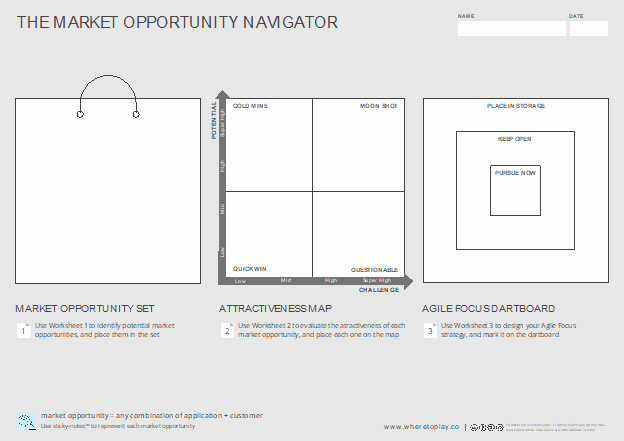

by dbward | Oct 11, 2021 | Innovation Coaching, Success Stories
Today’s post is co-authored by Bill Donaldson and Lauren Armbruster
ITK Trainee’s Perspective:
The road to becoming a certified Innovation Tool Kit (ITK) member is clear and full of community support-but it can also make the candidates a little nervous! For instance, one requirement is for all facilitators-in-training to run facilitation sessions while being observed by a veteran ITK member. Practice makes perfect…but I don’t think I’m alone in saying that we all wish we could be perfect on the first try! Thankfully, ITK members are trained to think positively and provide constructive feedback-which is exactly what I received from one of my observers, a certified ITK facilitator.
My experience with observation during an ITK practice was simple: I ran a Lotus Blossom brainstorming session as the sole moderator, Mural operator, and facilitator. I thought that the audience was engaged and able to meet the goals we had established in advance, plus have a little fun along the way-but I was looking forward to hearing what a more experienced facilitator might suggest as best practices for the future.
Team Toolkit Member Perspective:
I saw a post asking for someone to be an Observer during a Workshop through our internal channels. Knowing how hard it was for me to get those last items for ITK Certification, I was thrilled to help. “What an opportunity to help her get closer to her ITK certification”, I thought. Never giving it much though how I would actually do this, after all I’m a certificated ITK facilitator.
While in the session taking awesome notes, it came to me “how am I going to give her feedback?” So right after the end I did that ITK thing, improv.
I started with the COIN model, but wanted it to provide more of a critique than feedback. I used the Critque method (“I Like, I Wish”) from an ITK Lunch and Learn. This still didn’t convey what was accomplished by the ITK Trainee in her Workshop, so I then applied the ITK superpower of “AND” adding a User Journey on top like a ‘cherry’ on a sundae.
What is this sundae? At the base three columns: “I Like” and “I Wish” and “I Hope” Using “I” is a lighter way of providing feedback. Making the feedback specific things heard, seen, and felt. The User Journey is a great way to provide how things changed over time for the specific observations. But wait there’s more… all of this can be funner [yes this is a word]. Add icons, pictures, or even use a book or movie theme like to describe the Workshop. Humans are story sponges, our brains are wired to hear and remember stories. So make your observations reflect the story you saw and heard.
The recipe to recreate it…
1) Start with a quick meeting (15 mins) before the Workshop with the ITK Student for introductions and to get any specific areas for feedback. These areas can be used to plot on the User Journey. Make sure to ask how does the person like to get feedback. Even very well done feedback can be a surprise if not expected. Likewise, skipping this can make it hard on you to provide meaningful feedback when things appear to go awry.
2) During the Workshop record Observable events and the Impact on the Workshop (both the flow and the attendees) with the specific Context. These are from the COIN model
3) After do a scan for themes and group into three groups: “I Like” “I Wish” and “I Hope”.
- The “I Like” are that things your liked or even better when someone said they liked it during the Workshop.
- “I Wish” should be gentler then “areas of improvement”. When “you wish” something happened, it’s just that you wish. As the receiver I can grant your wish or not.
- “I Hope” give you the chance to push for something more or bigger that you see the observed person may not. You can make the case “I Hope” is the same as “I Wish” you wouldn’t be wrong. For me it was about the visual weight and appearance of 3:1 positive to negative comments.
4) Let the Story or theme come to you. Then find icons or pictures for observations and decorate the timeline. The entire effort should take under 30 minutes.
5) Meet with the ITK Student to present the Mural and let the Trainee define their Next steps. Start with asking the ITK Student how they thought they did. Use the exact words they gave you in step 1. Then go over the areas that aligned with their self-feedback and where you saw something different.
ITK Trainee Perspective:
I found this to be the easiest feedback session I have ever experienced at MITRE! I knew (somewhat) what to expect from it thanks to our expectations-setting conversation where I could identify specific areas that I was worried about or interested in them paying attention to. The timeline is a visual and intuitive way to track the progress of a full session. For me, this was most helpful to review very soon after I facilitated so I could remember my experience compared to what was observed and see if there were differences-and ask myself why that might be. Beginning with positive reinforcement through the “I Like” was a comfort and built me up before the more constructive “I Wish” and “You Might” feedback-but all of it was ‘light’ and easy to take and talk about thanks to the fun icons, memes, and imagery that were used throughout.
Overall, this form of feedback was easy to understand and a great mix of positive feedback and constructive criticism. It is highly recommended as a model to provide feedback to others within ITK and across MITRE after sponsor briefs, during annual feedback sessions, and beyond.
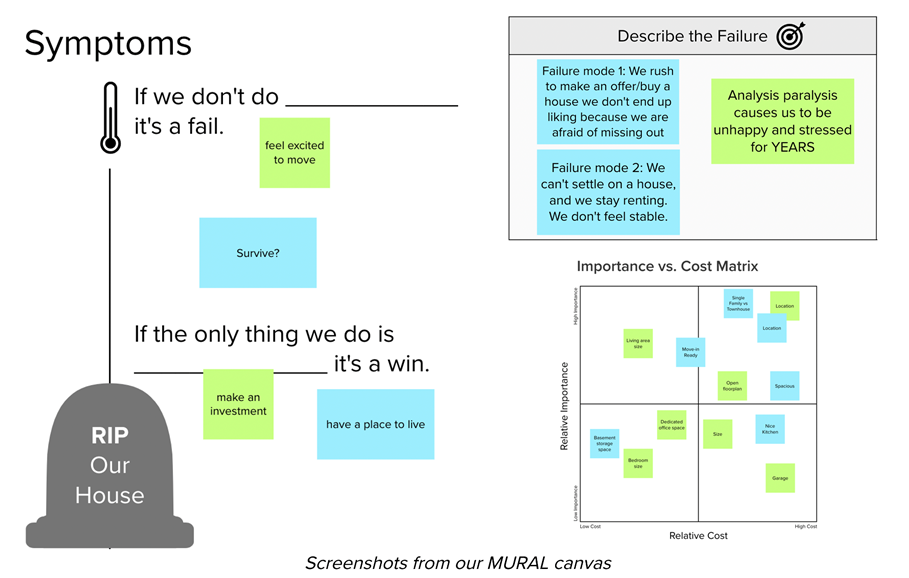
by ITK Administrator | Mar 22, 2021 | Success Stories, Tools 101
This week’s post is by Gabby Raymond
My husband, Ben, and I are at that happy stage of life where we are looking to buy a house together. What started off as a joyful hobby now feels like a full-fledged part-time job full of anxiety, anguish, and frustration. Those of you who have bought a house, especially in a market as hot as Boston is right now, probably know our pain. For the unenlightened, our house buying experience has been akin to proposing marriage to someone after your first blind date – equal parts fear, excitement, and “wow, this could cost me dearly if it goes poorly.”
Since training to become an ITK facilitator, I have found plenty of opportunities to apply ITK tools to my everyday life. After a particularly stressful open house where Ben and I were debating the merits of replacing our home search hobby with a home improvement hobby, we began to worry we would never actually buy a home. Over dinner and some beer, I told Ben I wanted to try out a Premortem with him. His first response was, “Premortem, is that when you kill me before we start?” After a good laugh, I described the tool to him: we’re preemptively trying to understand what failure looks like by describing a particularly bleak future (the bleaker the better), identifying the causes, and coming to a consensus on what success looks like. Sounds easy, right?
I realized after the open house that Ben and I had done a poor job communicating our individual goals because we were too worried about disagreeing. We needed to get everything out on the table. I set us up on different computers in different rooms to use MURAL, an online whiteboarding tool, to fill out a Premortem canvas. I used MURAL’s incognito mode to make sure we didn’t bias each other’s contributions. After 10 minutes of quiet working time, we cozied up on our couch together to discuss our canvas. Right away, we confirmed something we already knew – we were both tracking to the needs, desires, and goals of the other person. However, there were a few things that were surprisingly different.
Our biggest divergence was when answering the most important question on the canvas, “If the only thing we do is ______, it’s a win.” His answer – have a place to live. My answer – make an investment. It was a great dialogue point for some of the stress and anxiety we’d each been feeling. He was worried about the stability of having a house versus being at the will of a landlord. I was concerned that after years of saving up for a down payment we would purchase a house that would go down in value and flush our investment down the drain. Neither of us had vocalized those concerns directly, so it was helpful to talk openly.
We wrapped up the Premortem canvas by describing three failure scenarios and risk mitigations. It was refreshing to go from doom and gloom to planning for future successes. After the Premortem, we took our key house features and plotted them on a Cost x Importance matrix. Just like the Premortem exercise, the differences in our answers led to great conversations about tradeoffs and compromises.
Ben and I found our whiteboarding exercise to be valuable, both because we confirmed that we agree on the important aspects of our house search and because we came to a consensus on what success looks like in the big picture. We used MURAL’s incognito mode to foster clear dialogue without the concern of compromising in the moment or biasing each other’s opinions. In the end, framing of the conversation was just as important as the content.
We haven’t bought a house yet, but we know what we’re looking for… at least a little better than we did before!

by dbward | Dec 9, 2019 | Success Stories
This week’s guest post is by Rick Dunham, from MITRE’s Air/Ground Surveillance Program, and it highlights a recent application of the Innovation Toolkit to the F-35 program.

Lead Human Factors Engineer Jessica Yu (standing) briefs F-35 Lightning II Enterprise Focus team members on using the Innovation Toolkit.
On Nov. 5-6, MITRE’s F-35 Lightning II Enterprise Focus team met in Dayton, Ohio, to build collaborative FY20 strategic foundations, covering shared-knowledge, sponsor-specific deliverables and outcomes. The diverse team, which includes more than 65 MITRE engineers from across the U.S., is charged with delivering F-35 Continuous Capability Development and Deployment (C2D2) to the field faster and more efficiently.
An Air Force Portfolio High-Profile Program, F-35 Enterprise team leads Portfolio Manager Jen Hebert and Project Leader Chris Jella—facilitated by the Innovation Toolkit Team—pioneered and challenged four main focus area groups: Reduce Live Fly; Implement Advance Capabilities; Integrate US, Partner, and International Efforts; and Modernize Mission Support and Infrastructures. The goal is to leverage and link cross-functional expertise in building shared mission-driven impactful products and outcomes.
This team-based approach and visionary mindset is why our F-35 Enterprise sponsors have come to rely on MITRE to organize work so that it magnifies the delivered capability to any one individual sponsor. By synthesizing MITRE’s internal, full-spectrum-funded research, labs, direct sponsor work, and related activities, the government pays once for a capability that benefits many sponsors and stakeholders.
 Additionally, shared deliverables are a centerpiece of the MITRE F-35 Enterprise strategy. Each focus area group has both a set of sponsor-specific deliverables and a well-crafted outcome that contributes to a higher strategy while addressing local sponsor priorities.
Additionally, shared deliverables are a centerpiece of the MITRE F-35 Enterprise strategy. Each focus area group has both a set of sponsor-specific deliverables and a well-crafted outcome that contributes to a higher strategy while addressing local sponsor priorities.
This collaborative, get-to-know-you comradery structure will pay dividends, strengthening MITRE’s core excellence and service and ultimately, solving our sponsor’s most challenging C2D2 needs.
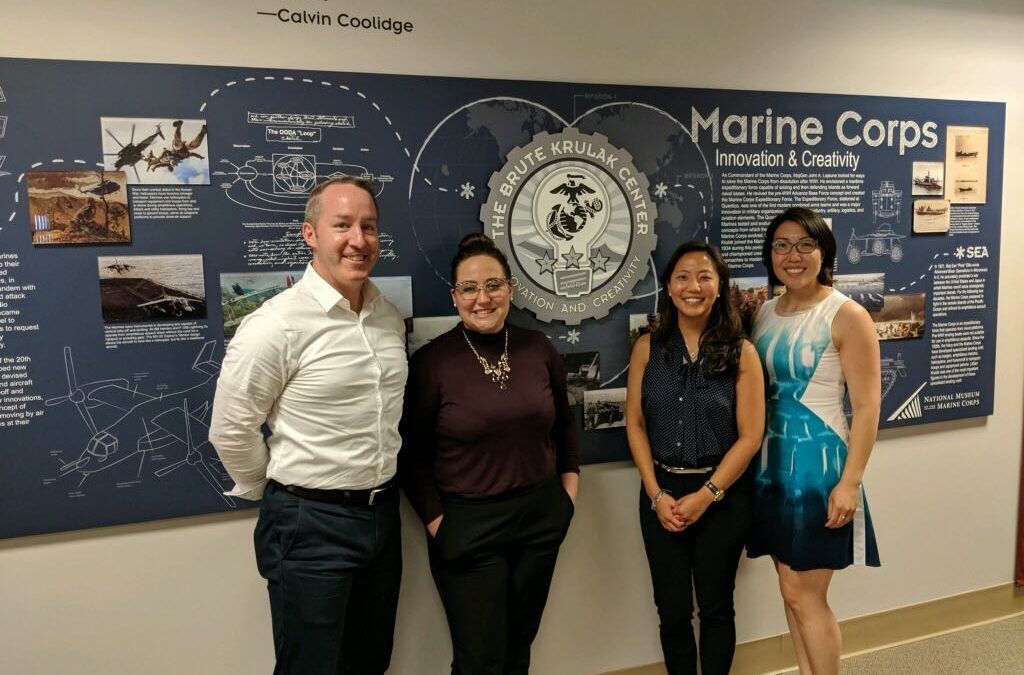
by choij | Sep 30, 2019 | Success Stories, Team Toolkit
Hot. Muggy. Humid. Like a swamp (but not really).
Yep, I’m talking about DC summers. The time when tourists and summer interns descend en masse upon the District, and the locals grumble about these visitors mistakenly standing on the left side of the metro escalators.
But now that the kids have gone back to school, the mornings have a brisk chill, and the green trees are starting to show their first yellow leaves, it’s time for us summer lovers to accept the inevitable: Fall is coming.
With any change in seasons, it’s a prime time to reflect on the past season to savor the good moments and make course corrects for the next one.
For me, my favorite ITK summer memory was by far our “ITK DC Roadshow” to bring our Innovation Workshop to the National Academy of Sciences, the National Academy of Public Administration, and the US Marine Corps Brute Krulak Center for Innovation and Creativity.
Based on their interest and unique requests, Team Toolkit developed a custom Innovation Workshop that took participants on a lightning round lesson on three ITK tools (Problem Framing, Value Proposition Canvas, and Culture Change Canvas). They learned how to use these tools and applied them for current problems with us there to guide them.
It was an absolute delight working with such engaged and dynamic participants: We were truly impressed by their eagerness, their hunger for innovation, and their willingness to try something different.
And we learned so much from them too! We found fellow comic makers and problem framing enthusiasts, and our own perspectives and world views were positively widened from our workshop conversations.
But the best part was the “Train the Trainer” portions of our workshop: Rather than being only a participant, we invited our audiences to also become co-conspirators of innovation by teaching them how to lead the use of these tools on their own teams without us.
Let’s let that soak in a bit… remember the saying about the man and the fish?
Give a man a fish, and you feed him for a day.
Teach a man to fish, and you feed him for a lifetime.
Yes, that one. By teaching our audiences how to use ITK tools, and the practices and mindsets behind them, we created the first of hopefully many future cohorts of co-conspirators.
We at Team Toolkit are passionate about democratizing innovation and believe that anyone and everyone can be an innovator. We created the ITK toolkit to provide tools and a structured process to help you get there faster because helping you ultimately helps all of us.
Have a question on the ITK tools? Want an ITK Innovation Workshop at your organization? Not sure where to start but know you want to?! Contact us! We’re here to help and can’t wait to connect with you.









 Additionally, shared deliverables are a centerpiece of the MITRE F-35 Enterprise strategy. Each focus area group has both a set of sponsor-specific deliverables and a well-crafted outcome that contributes to a higher strategy while addressing local sponsor priorities.
Additionally, shared deliverables are a centerpiece of the MITRE F-35 Enterprise strategy. Each focus area group has both a set of sponsor-specific deliverables and a well-crafted outcome that contributes to a higher strategy while addressing local sponsor priorities.